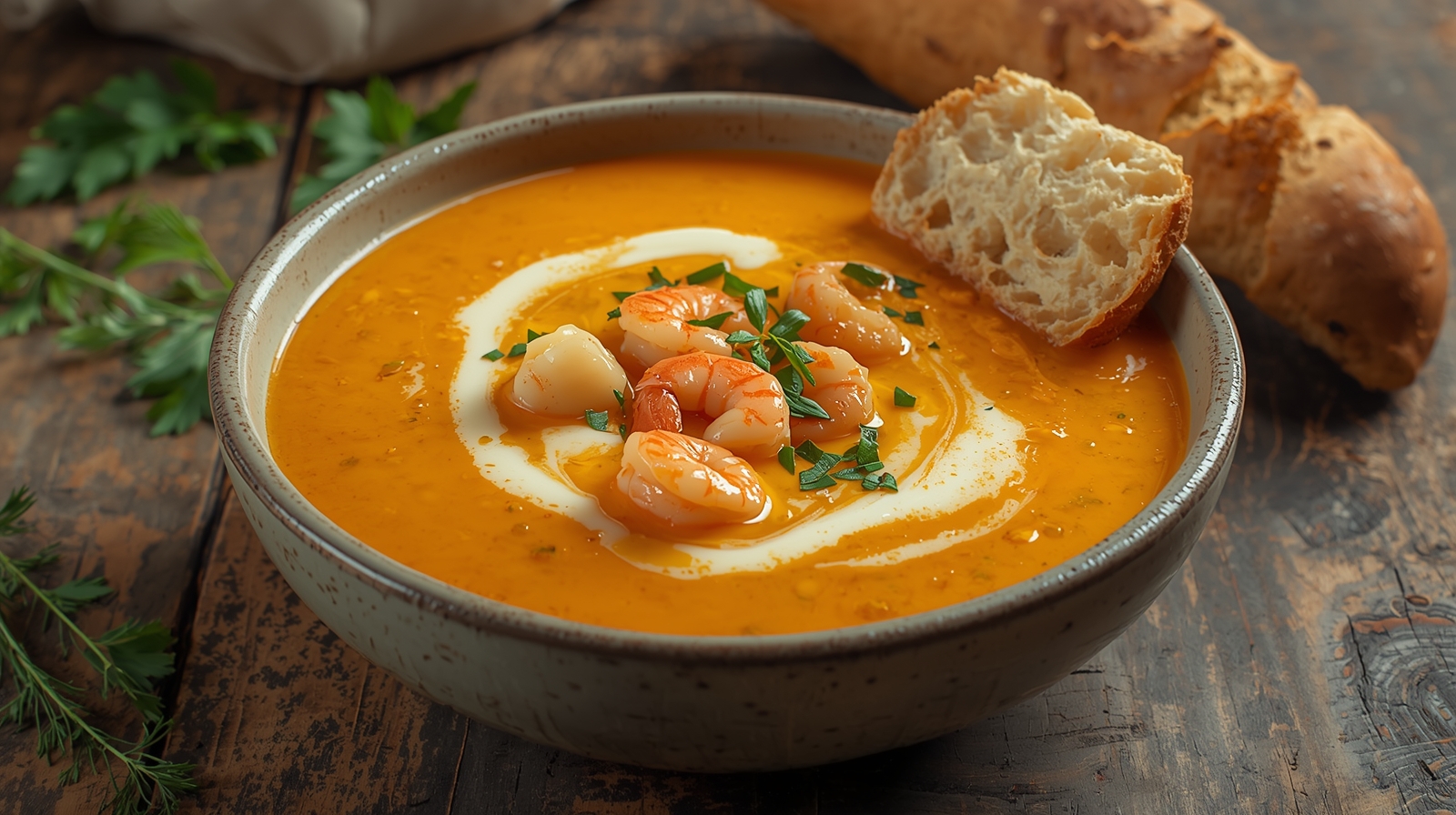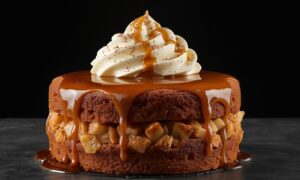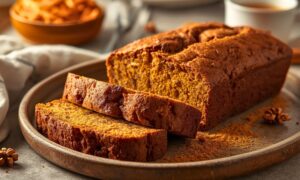I don’t need a five star kitchen to feel alive, give me a campsite, a roaring fire, and a line in the water, and I’m set. That’s where the craving hit me hardest: a bowl of crab and shrimp seafood bisque that tastes like luxury but still feels wild enough to belong under the open sky. Out there, you learn quickly that real flavor doesn’t come from fancy gadgets, it comes from respecting every part of what you cook.
This isn’t soup you sip politely. It’s bold, creamy, and brimming with ocean bite. The secret? Don’t toss those crab shells and shrimp tails, they’re the backbone of the broth. Simmer them low and slow, and you unlock a depth of flavor no boxed stock can compete with. It’s the kind of kitchen wisdom that feels both primal and comforting, like food that’s been passed down from campfires to kitchens.
Think of it as survival food that got a glow up, comfort wrapped in velvet, with just enough swagger to keep things exciting. Every spoonful carries both story and skill: the memory of smoke and nets, and the knowledge that flavor lives in the details most people overlook. That’s the kind of bisque that doesn’t just feed you, it teaches you why food matters.
Getting Started: The Foundation of Flavor
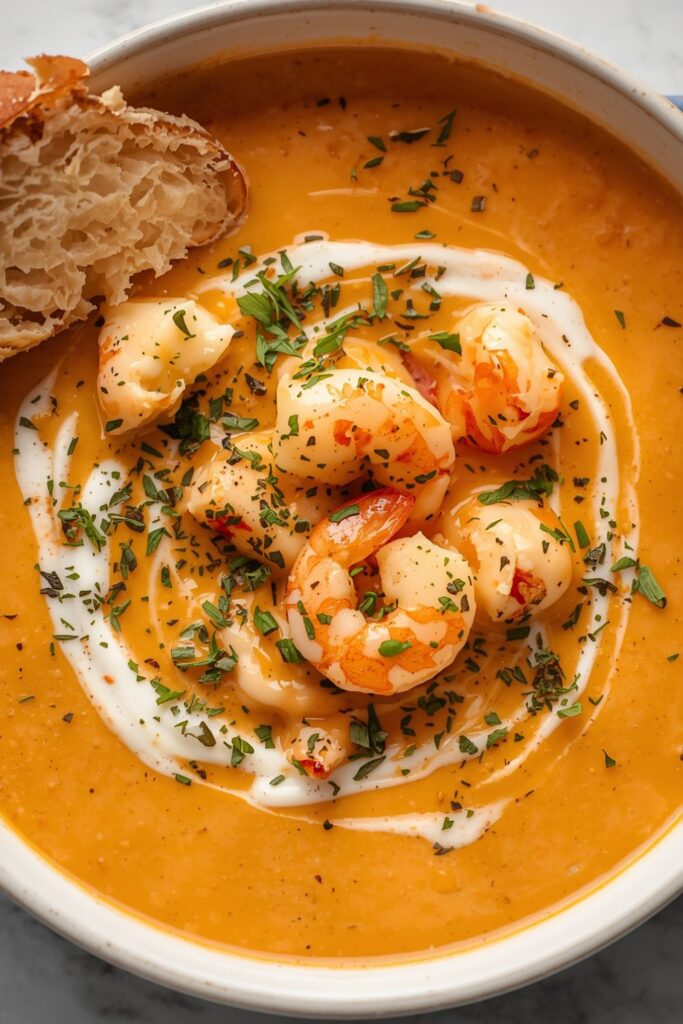
Every great bisque starts with a decision. Do you want restaurant quality results or just something that tastes okay? If you’re here for okay, this recipe isn’t for you. We’re going for the kind of bisque that makes people lean back in their chairs and sigh with satisfaction.
The magic happens in layers. First, we build a shellfish stock that’ll make you question every seafood dish you’ve ever made. Then we create a base that’s rich without being heavy. Finally, we add our star performers, the crab and shrimp, at just the right moment.
This isn’t difficult cooking. It’s patient cooking. There’s a difference. You don’t need fancy knife skills or expensive equipment. You just need to trust the process and let each step do its work.
The beauty of bisque lies in its transformation. What starts as humble shells and vegetables becomes something luxurious. Something that feels like a celebration even on a random Wednesday night.
Essential Ingredients for Perfect Crab and Shrimp Seafood Bisque
Here’s what you’ll need, listed in the order you’ll actually use them. None of that grocery store organization, we’re thinking like cooks here.
For the Shell Stock:
- 1 pound crab shells (ask your fishmonger or save from previous meals)
- 1 pound shrimp shells and heads (don’t you dare throw these away)
- 2 tablespoons olive oil
- 1 large onion, roughly chopped
- 2 carrots, roughly chopped
- 2 celery stalks, roughly chopped
- 3 garlic cloves, smashed
- 2 tablespoons tomato paste
- 1/2 cup dry white wine
- 8 cups water
- 2 bay leaves
- 4-5 fresh thyme sprigs
For the Bisque:
- 3 tablespoons butter
- 1 medium onion, finely diced
- 2 celery stalks, finely diced
- 1 carrot, finely diced
- 3 garlic cloves, minced
- 3 tablespoons all purpose flour
- 1/4 cup cognac or brandy (trust me on this)
- 4 cups of your gorgeous homemade stock
- 1 cup heavy cream
- 1 pound lump crabmeat, picked clean
- 1 pound medium shrimp, peeled and deveined
- Salt and white pepper to taste
- Cayenne pepper (just a pinch)
- Fresh chives for garnish
Smart Ingredient Swaps and Shopping Tips
Can’t find crab shells? Many grocery stores will sell them separately, or ask when they’re breaking down whole crabs. Some fishmongers will even save them for you if you call ahead. No luck? Substitute with lobster shells or double up on the shrimp shells.
That cognac isn’t just for show. It adds depth that makes people wonder what your secret is. But if you don’t drink, apple juice works surprisingly well. The sweetness plays beautifully with the seafood.
Heavy cream is king here, but if you’re watching calories, half and half works too. Just add it slowly and don’t let it boil. Scorched dairy is nobody’s friend.
When buying crabmeat, spring for lump if your budget allows. Those beautiful chunks make each bite special. But don’t stress if you need to use claw meat. The flavor’s still incredible.
Choose shrimp that smell like the ocean, not like… well, anything else. Fresh is ideal, but good frozen shrimp beats questionable fresh every time.
Step by Step Magic: Building Your Bisque
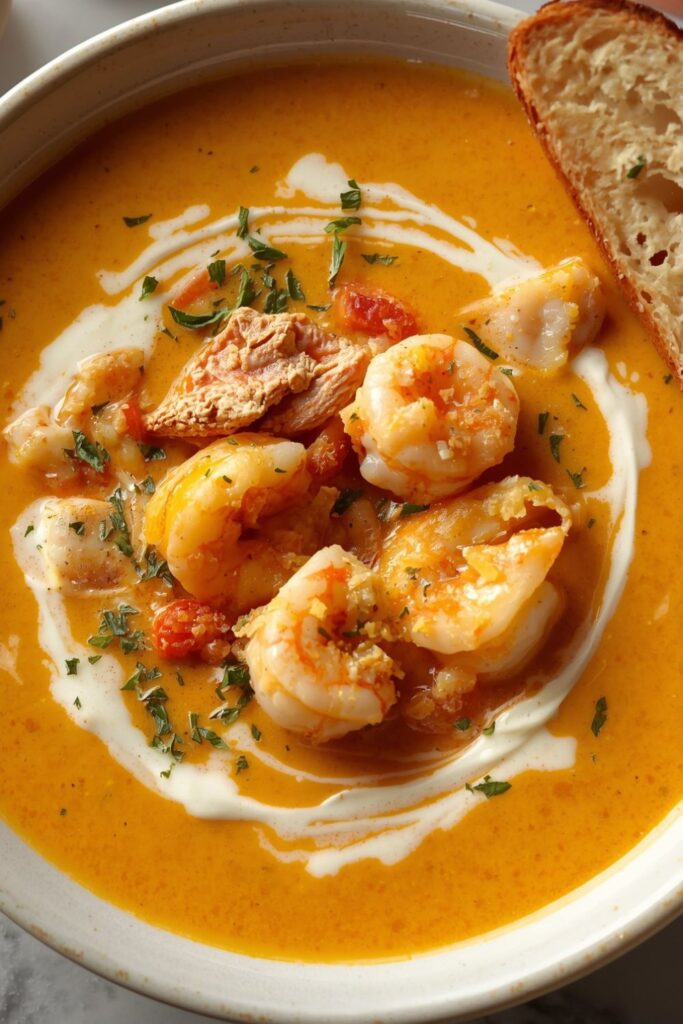
Creating the Shell Stock
Heat that olive oil in your biggest pot. You want those shells to sizzle when they hit the oil. This isn’t gentle cooking, we’re building flavor through caramelization.
Toss in all your shells and let them go. Stir occasionally, but don’t hover. You want them golden and aromatic. This takes about 10 minutes and smells like pure ocean heaven.
Add your rough chopped vegetables. Let them get friendly with those shells for another 5 minutes. The vegetables should start softening and picking up that gorgeous shell flavor.
Stir in the tomato paste and let it cook for a minute. It’ll darken and smell sweet. That’s concentrated umami happening right in your pot.
Pour in that wine and scrape up any golden bits stuck to the bottom. Those bits are flavor gold. Let the wine bubble and reduce by half.
Cover everything with water and add your herbs. Bring it to a boil, then drop to a gentle simmer. Let it go for at least an hour. Ninety minutes is even better.
Strain this liquid gold through a fine mesh strainer. Press those solids to extract every drop of flavor. You should have about 6 cups of the most aromatic stock you’ve ever made.
Building the Bisque Base
Clean your pot and melt that butter over medium heat. Add your finely diced vegetables, the holy trinity of onion, celery, and carrot. Cook until soft and translucent, about 8 minutes.
Add the minced garlic and cook until fragrant. About 30 seconds. Garlic burns fast, so watch it like a hawk.
Sprinkle in the flour and stir constantly for 2 minutes. This cooks out the raw flour taste and creates our thickening base. It should smell nutty and toasted.
Here comes the fun part. Pull the pot off the heat and add that cognac. It might flame up, that’s normal and actually desirable. The alcohol burns off, leaving pure flavor behind.
Slowly whisk in your beautiful shell stock. Start with just a cup, whisking constantly. Then add the rest gradually. This prevents lumps and creates silky smoothness.
Bring to a gentle simmer and cook for 20 minutes. The bisque should thicken slightly and taste like concentrated ocean essence.
The Final Touch
Stir in the heavy cream and let it warm through. Don’t boil it, just warm and dreamy.
Season with salt, white pepper, and just a whisper of cayenne. Taste as you go. Each batch of stock tastes slightly different, so trust your palate.
Add the crabmeat and shrimp. Here’s the crucial part: don’t overcook the seafood. The shrimp just need to turn pink and curl. The crab just needs to warm through. Two to three minutes max.
Taste one more time and adjust seasoning. Sometimes a tiny bit more salt makes everything sing. Sometimes it needs another pinch of cayenne.
The Science Behind the Sizzle
Why do we brown those shells so aggressively? It’s called the Maillard reaction, the same process that makes bread crusts golden and steaks delicious. Those shells contain proteins and natural sugars that caramelize under heat, creating hundreds of new flavor compounds.
The tomato paste isn’t just color. It’s concentrated glutamates, natural MSG that makes everything taste more like itself. When it darkens in the pot, those glutamates become even more concentrated.
That flour and butter mixture is called a roux in French cooking. It’s not just thickening the bisque; it’s creating body and richness. The key is cooking it long enough to eliminate any starchy taste but not so long that it loses its thickening power.
Cognac does more than add alcohol flavor. It contains compounds that enhance seafood flavors specifically. That’s why it’s been paired with shellfish for centuries. The brief flambé burns off the harsh alcohol while concentrating the flavor essences.
The slow simmer is crucial. Boiling would make the proteins tough and the cream separate. Gentle heat keeps everything silky and allows flavors to meld rather than compete.
Making It Beautiful and Delicious
Presentation matters with bisque. This is elegant food that deserves elegant treatment. Warm your bowls, it keeps the bisque at perfect temperature longer.
Ladle carefully to ensure each portion gets plenty of seafood. A few fresh chives scattered on top add color and a mild onion note that complements the richness.
Serve with crusty bread or oyster crackers. The contrast of textures makes each spoonful more interesting. Some people love a drizzle of good sherry on top, but that’s purely optional.
Wine pairing is simple: crisp white wines work beautifully. Chablis, Sancerre, or a good Pinot Grigio all complement without competing. If you prefer red, go light, a Pinot Noir from Oregon or Burgundy.
This bisque is rich, so serve reasonable portions. Six ounces is plenty for most people. You want them satisfied, not overwhelmed.
Troubleshooting Your Crab and Shrimp Seafood Bisque
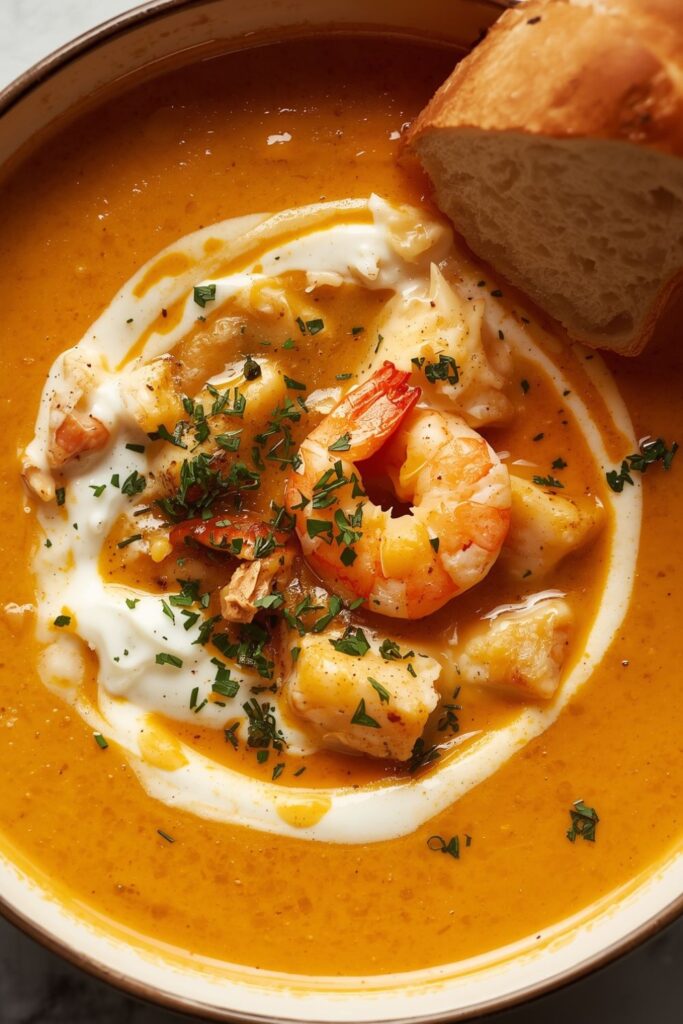
Sometimes things go sideways in the kitchen. Here’s how to fix common bisque problems:
Bisque too thin? Mix 2 tablespoons cornstarch with cold water to make a slurry. Stir it in gradually while simmering. Or simmer uncovered longer to reduce naturally.
Cream separated? Take it off the heat immediately. Whisk in a tablespoon of cold butter. This often brings it back together. Prevention is better, never boil cream.
Too salty? Add a peeled potato and simmer for 15 minutes, then remove it. The potato absorbs excess salt. A splash of cream can also help balance saltiness.
Seafood rubbery? This happens when it’s overcooked. Next time, add it at the very end just to warm through. Already rubbery? Remove it, dice it smaller, and fold it back in.
Lacks depth? More shells in your stock next time. For now, a tablespoon of fish sauce works magic. Sounds weird, tastes incredible.
Frequently Asked Questions
Can I make crab and shrimp seafood bisque ahead of time?
Absolutely, but with a caveat. Make everything up to adding the seafood. Cool completely and refrigerate for up to two days. When ready to serve, reheat gently and add your crab and shrimp then. This prevents overcooking and keeps the seafood tender.
The stock component can be made days ahead. In fact, it often tastes better after the flavors have time to marry. Just store it covered in the fridge and use within three days.
What’s the best way to clean crabmeat?
Spread the crabmeat on a large plate or baking sheet. Pick through it carefully with your fingers, feeling for bits of shell or cartilage. Don’t rinse it, that washes away flavor. Be gentle so you don’t break up those beautiful lumps.
If you’re using frozen crabmeat, thaw it in the refrigerator overnight. Drain any excess liquid before using. Fresh is ideal, but quality frozen crabmeat makes an excellent bisque.
Can I substitute other seafood in this recipe?
Lobster is the most obvious swap, use the shells and meat just like crab. Scallops work beautifully too, though they don’t provide shells for stock. In that case, use more shrimp shells or add some fish bones to your stock base.
Avoid delicate fish like sole or flounder. They fall apart in the bisque. Firmer fish like monkfish or halibut work if you add them at the very end.
How do I store leftover bisque?
Refrigerate in airtight containers for up to three days. Reheat gently, never boil leftover bisque or the cream will separate and the seafood will become tough.
Freezing is tricky with cream based soups, but possible. Freeze without the cream, then add fresh cream when reheating. The texture might change slightly, but the flavor remains excellent.
Why does my bisque taste flat?
Under seasoning is the usual culprit. Bisque needs more salt than you might expect because cream dulls flavors. Add salt gradually and taste frequently. A squeeze of lemon juice brightens flavors too.
Also check your stock. If the shell stock lacks depth, the finished bisque will too. Next time, brown those shells longer and simmer the stock for at least 90 minutes.
Your Culinary Victory
This crab and shrimp seafood bisque isn’t just soup, it’s edible luxury. It’s the dish that turns a regular dinner into an occasion. The kind of recipe that makes people remember your cooking long after the last spoonful.
Master this technique and you’ll never look at seafood shells the same way. Those discarded parts become the foundation for restaurant quality results in your own kitchen. It’s cooking alchemy at its finest.
The beauty lies in the process as much as the result. There’s something meditative about the slow simmer, the careful seasoning, the final flourish of adding the seafood. It connects you to generations of cooks who understood that the best things can’t be rushed.
Start with quality ingredients and trust the process. Your patience will be rewarded with a bisque that’s rich without being heavy, complex without being complicated. Each spoonful should taste like pure ocean essence, elevated by cream and technique into something truly special.
Don’t save this for special occasions. Sometimes the best way to make a day special is to cook something spectacular. Your kitchen, your rules. Make this bisque whenever you need a little luxury in your life.
Remember, cooking is about more than following instructions. It’s about understanding why each step matters and making the dish your own. Once you’ve made this bisque a few times, start experimenting. Add a touch of saffron. Try different herbs. Make it yours.
The most important ingredient isn’t listed in any recipe: confidence. Cook with joy, taste as you go, and trust your instincts. That’s what separates good cooks from great ones. You’ve got this.

Swiftly Captions by Tina Smith — Quick, flavorful food recipes made simple, bringing fresh inspiration to your kitchen every day
